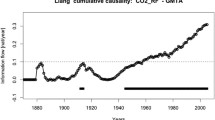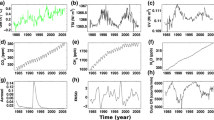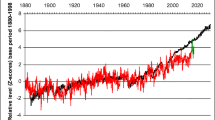Abstract
We apply a novel method based upon “before” and “after” relationships to investigate and quantify interconnections between global temperature anomaly (GTA), as response variable, and greenhouse gases (CO2) and total solar irradiance (TSI) as candidate causal variables for the period 1880 to 2010. The most likely interpretations of our results for the 6 to 8 years cyclic components of the variables are that during the period 1929 to 1936, CO2 significantly leads GTA. However, during the period 1960–2003, GTA apparently leads CO2, that is, the peaks (and troughs) in GTA are in front of, and close to, the peaks (and troughs) in CO2. For time windows outside these periods, we did not find significant before or after-relations. An alternative interpretation is that there is a shift between short (≈1.5 year) and long (≈5 years) durations between cause and effect. Relationships between GTA and TSI suggest that “inertia” of the global sea, land, and atmosphere system leads to delays longer than half their common cycle length of about 10 years. Based on the interaction patterns between the variables GTA, CO2, and TSI, we suggest the possibility that a new regime for how the variables interact started around 1960. From trend forms, and not considering physical mechanisms, we found that the trend in CO2 contributes ≈ 90 %, and the trend in TSI ≈ 10 %, to the trend in GTA during the last 130 years.







Similar content being viewed by others
Notes
It can be implemented in Excel format: with v1 = (A1,A2,A3) and v2 = (B1,B2,B3) in an Excel spread sheet, the angle is calculated by pasting the following Excel expression into C2: = SIGN((A2-A1)*(B3-B2)-(B2-B1)*(A3-A2))*ACOS(((A2-A1)*(A3-A2) + (B2-B1)*(B3-B2))/(SQRT((A2-A1)2 + (B2-B1)2)*SQRT((A3-A2)2 + (B3-B2)2))).
References
Anav A, Friedlingstein P, Kidston M, Bopp L, Ciais P, Cox P, Jones C, Jung M, Myneni R, Zhu Z (2013) Evaluating the land and ocean components of the global carbon cycle in the CMIP5 earth system models. J Clim 26(18):6801–6843
Andrews MB, Knight JR, Gray LJ (2015) A simulated lagged response of the north Atlantic oscillation to the solar cycle over the period 1960–2009. Environ Res Lett 10(5)
Bacastow RB (1976) Modulation of atmospheric carbon dioxide by the southern oscillation. Nature 261:116–118
Chylek P, Dubey MK, Lesins G, Li JN, Hengartner N (2014a) A). Imprint of the Atlantic multi-decadal oscillation and Pacific decadal oscillation on southwestern US climate: past, present, and future. Clim Dyn 43(1–2):119–129
Chylek P, Klett JD, Lesins G, Dubey MK, Hengartner N (2014b) b). The Atlantic multidecadal oscillation as a dominant factor of oceanic influence on climate. Geophys Res Lett 41(5):1689–1697
Clette F, Svalgaard L, Vaquero JM, Cliver EW (2014) Revisiting the sunspot number a 400-year perspective on the solar cycle. Space Sci Rev 186(1–4):35–103
Cooley, T. F. and E. C. Prescott (1995). Economic growth and business cycles (Chapt. 1.). Frontiers of business cycle research. T. F. Cooley. Princeton, Princeton university press: 1–38.
Crick FHC (1988) What mad pursuit. A personal view of scientific discovery. Basic Books, Inc, New York
DelSole T, Tippett MK, Shukla J (2011) A significant component of unforced multidecadal variability in the recent acceleration of global warming. J Clim 24(3):909–926
Feldman DR, Collins WD, Gero PJ, Torn MS, Mlawer EJ, Shippert TR (2015) Observational determination of surface radiative forcing by CO2 from 2000 to 2010. Nature 519(7543):339 − +
Finlay K, Vogt RJ, Bogard MJ, Wissel B, Tutolo BM, Simpson GL, Leavitt PR (2015) Decrease in CO2 efflux from northern hardwater lakes with increasing atmospheric warming. Nature 519(7542):215–218
Foster G, Rahmstorf S (2011) Global temperature evolution 1979–2010. Environ Res Lett 6:8
Frøhlich C (2009) Evidence of a long-term trend in total solar irradiance. Astronomy & Astrophysics 501(3):L27–U508
Gao LH, Yan ZW, Quan XW (2015) Observed and SST-forced multidecadal variability in global land surface air temperature. Clim Dyn 44(1–2):359–369
Haigh JD, Winning AR, Toumi R, Harder JW (2010) An influence of solar spectral variations on radiative forcing of climate. Nature 467(7316):696–699
Humlum O, Solheim JE, Stordahl K (2011) Identifying natural contributions to late Holocene climate change. Glob Planet Chang 79(1–2):145–156
Ineson S, Maycock AC, Gray LJ, Scaife AA, Dunstone NJ, Harder JW, Knight JR, Lockwood M, Manners JC, Wood RA (2015) Regional climate impacts of a possible future grand solar minimum. Nat Commun 6. doi:10.1038/ncomms8535
Karl TR, Arguez A, Huang BY, Lawrimore JH, McMahon JR, Menne MJ, Peterson TC, Vose RS, Zhang HM (2015) Possible artifacts of data biases in the recent global surface warming hiatus. Science 348(6242):1469–1472
Keeling CD, Whorf TP (1997) Possible forcing of global temperature by oceanic tides. Proc Natl Acad Sci U S A 94:8321–8328
Kjeldseth-Moe O, Wedenmeyer-Böhm S (2009) Are there variations in earth’s global mean temperature related to the solar activity? Impact on Earth and Planets, International Astronomical Union, Solar and Stellar Variability
Kleinbaum DG, Kupper LL, Muller KE (1988) Applied regression analysis and other multivariate methods. PES-KENT publishing company, Boston
Luterbacher J, Xoplaki E, Dietrich D, Rickli R, Jacobeit J, Beck C, Gyalistras D, Schmutz C, Wanner H (2002) Reconstruction of sea level pressure fields over the eastern north Atlantic and Europe back to 1500. Clim Dyn 18(7):545–561
Martinez-Boti MA, Marino G, Foster GL, Ziveri P, Henehan MJ, Rae JWB, Mortyn PG, Vance D (2015) Boron isotope evidence for oceanic carbon dioxide leakage during the last deglaciation. Nature 518(7538):219–U154
Mazzarella A, Scafetta N (2012) Evidences for a Quasi 60-year north Atlantic oscillation since 1700 and its meaning for global climate change. Theor Appl Climatol 107(3–4):599–609
McCarthy GD, Haigh ID, Hirschi JIJ-M, Grist JP, Smeed DA (2015) Ocean impact on decadal Atlantic climate variability revealed by sea-level observations. Nature 521:508–510. doi:10.1038/nature14491
Meehl GA, Arblaster JM, Fasullo JT, Hu AX, Trenberth KE (2011) Model-based evidence of deep-ocean heat uptake during surface-temperature hiatus periods. Nat Clim Chang 1(7):360–364
Meehl GA, Arblaster JM, Matthes K, Sassi F, van Loon H (2009) Amplifying the Pacific climate system response to a small 11-year solar cycle forcing. Science 325(5944):1114–1118
Meehl GA, Hu AX, Arblaster JM, Fasullo J, Trenberth KE (2013) Externally forced and internally generated decadal climate variability associated with the interdecadal Pacific oscillation. J Clim 26(18):7298–7310
Meehl GA, Teng HY, Arblaster JM (2014) Climate model simulations of the observed early-2000s hiatus of global warming. Nat Clim Chang 4(10):898–902
Munk W, Dzieciuch M, Jayne S (2002) Millennial climate variability: is there a tidal connection? J Clim 15(4):370–385
NASA(GHG). (2014). Greenhouse gases and Total solar irradiance. from http://data.giss.nasa.gov/modelforce/RadF.txt
NASA(GISTEMP). (2014). GISS Surface Temperature Analysis (GISTEMP). 2012, from http://data.giss.nasa.gov/gistemp
Power SB, Kociuba G (2011) What caused the observed twentieth-century weakening of the walker circulation? J Clim 24(24):6501–6514
Ray RD (2007) Decadal climate variability: is there a tidal connection? J Clim 20(14):3542–3560
Ring MJ, Lindner D, Cross E, Schlesinger FME (2012) Causes of the global warming observed since the 19th century. Atmospheric and Climate sciences 2:401–415
Seip KL (2015) Investigating possible causal relations among physical, chemical and biological variables across regions in the gulf of Maine. Hydrobiologia 744:127–143
Seip KL, McNown R (2007) The timing and accuracy of leading and lagging business cycle indicators: a new approach. Int J Forecast 22:277–287
Seip KL, Pleym H (2000) Competition and predation in a seasonal world. Verh Internat Verein Limnol 27:823–827
Seip KL, Reynolds CS (1995) Phytoplankton functional attributes along trophic gradient and season. Limnol Oceanogr 40:589–597
Solheim JE, Stordahl K, Humlum O (2012) The long sunspot cycle 23 predicts a significant temperature decrease in cycle 24. J Atmos Sol Terr Phys 80:267–284
SORCE (2015) Total solar irradiance data. http://lasp.colorado.edu/home/sorce/data/tsi-data/
Stocker, T. (2014). Climate change 2013 : the physical science basis : Working Group I contribution to the Fifth assessment report of the Intergovernmental Panel on Climate Change. Cambridge university press
Wen GY, Cahalan RF, Haigh JD, Pilewskie P, Oreopoulos L, Harder JW (2013) Reconciliation of modeled climate responses to spectral solar forcing. J Geophys Res-Atmos 118(12):6281–6289
White WB, Cayan DR (1998) Quasi periodicity and global symmetries in interdecadal upper ocean temperature variability. J Geophys Res 103:21335–21354
Wu S, Liu ZY, Zhang R, Delworth TL (2011b) On the observed relationship between the Pacific decadal oscillation and the Atlantic multi-decadal oscillation. J Oceanogr 67(1):27–35
Wu ZH, Huang NE, Wallace JM, Smoliak BV, Chen XY (2011a) On the time-varying trend in global-mean surface temperature. Clim Dyn 37(3–4):759–773
Zhen-Shan L, Xian S (2007) Multi-scale analysis of global temperature changes and trend of a drop in temperature in the next 20 years. Meteorog Atmos Phys 95(1–2):115–121
Zhou J, Tung K-K (2010) Solar cycles in 150 years of global sea surface temperature data. J Clim 23:3234–3248
Acknowledgments
We would like to thank Robert McNown for pointing out important literature for this study and for help in developing the leading-lagging ideas for climate studies. We thank Hans Martin Seip for pointing out relevant literature and for giving us useful comments and advices and Jostein-Riiser Kristiansen for providing the reference to Kjeldseth-Moe and Wedenmeyer-Böhm (2009). We would also like to thank two anonymous referees for constructive criticism and helpful comments. All data are available from the sources cited in the materials section of the paper, but are also supplied in Excel format as supporting information.
Author information
Authors and Affiliations
Corresponding author
Electronic supplementary material
ESM 1
(PDF 372 kb)
Rights and permissions
About this article
Cite this article
Seip, K.L., Grøn, Ø. A New method for identifying possible causal relationships between CO2, total solar irradiance and global temperature change. Theor Appl Climatol 127, 923–938 (2017). https://doi.org/10.1007/s00704-015-1675-8
Received:
Accepted:
Published:
Issue Date:
DOI: https://doi.org/10.1007/s00704-015-1675-8




